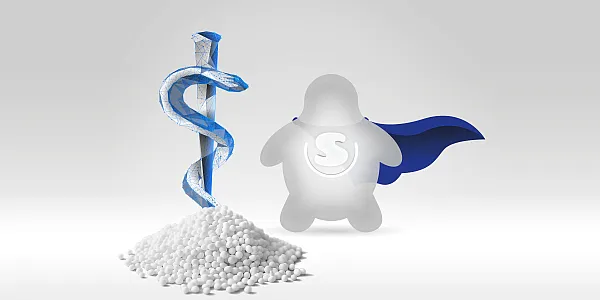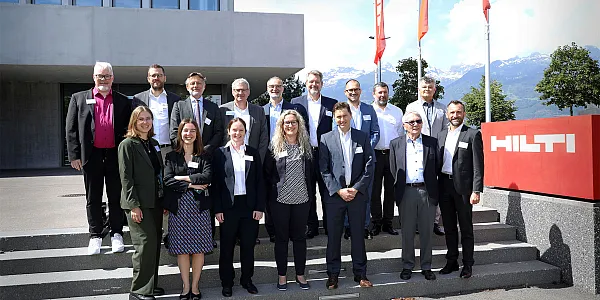Run Photon run… mit Compounds von KRAIBURG TPE
Pädagogischer Roboter „fühlt“ und „blickt“ mit transparentem TPE gemäß Spielzeugnorm EN 71/3
KRAIBURG TPE liefert die Thermoplastischen Elastomere (TPE) für mehrere Funktionsbauteile des innovativen Lernroboters Photon. Für die Laufprofile sowie die Fühler und Augen des interaktiven Roboters kommen zwei bewährte THERMOLAST® K Compounds zum Einsatz, darunter ein hochtransparentes Produkt der Serie FC/ht im Einklang mit der Spielzeugnorm DIN EN 71-3.
Mit dem Lernroboter Photon hat die in Białystok (Polen) ansässige Photon Entertainment Sp. z o. o. einen pädagogischen Roboter auf den Markt gebracht, der Kindern beim spielerischen Erweitern ihrer logischen Fähigkeiten hilft. Der Photon wird mit Hilfe einer mittigen Lenkrolle gesteuert und läuft auf zwei seitlichen hinteren Rädern, deren Profile aus einem THERMOLAST® K Compound der Serie GP/FG gefertigt werden. Zwei transparente Fühler am Kopf dienen als Antennen bzw. Lichtsensoren, und für ein „emotionales“ Feedback verfügt der Roboter über zwei Augen, die wie die Fühler ihre Farbe wechseln können. Fühler und Augen bestehen aus einem Compound der THERMOLAST® K Familie FC/ht.
„Für uns war es wichtig, dass die Kinder den Roboter nicht als ein primär technisches Spielzeug erleben, sondern als einen interaktiven Begleiter, der logisches Denken fördert und ‚spielend‘ die Welt der Robotisierung und Digitalisierung erkunden lässt“, sagt Michał Grześ, Mitbegründer von Photon Entertainment. „Natürlich haben wir bei der Entwicklung auch auf die Einhaltung strengster Standards geachtet, einschließlich der EN 71-3, die das Migrationsverhalten und die physiologische Unbedenklichkeit von Spielzeugmaterialien sowie deren Schwerentflammbarkeit regelt.“
Der Lernroboter wurde nicht zufällig in der Universitätsstadt Białystok im Osten Polens erfunden. Die dortige Technische Hochschule gilt spätestens seit der University Rover Challenge 2014 in den USA weltweit als „Think Tank“ für innovative Robotik. Denn es war bereits das dritte Mal, dass ein Team aus Białystok den Wettbewerb gewann – mit dem unter Leitung von Grześ konstruierten Mars-Roboter Hyperion 2.
Białystok ist auch Sitz der Experteam Sp. z o. o., die sich auf innovative Kunststoffanwendungen spezialisiert hat und die Spritzgussteile für den Photon liefert. „Die Laufprofile, Fühler und Augen des Roboters sind grundlegende Funktions- und Interaktionsbauteile, für die wir Materialien suchten, die sich angenehm anfühlen und dennoch die nötige, dauerhafte Robustheit im alltäglichen Einsatz sicherstellen“, erläutert Paweł Matczuk, New Project Introduction Manager bei Experteam. „Die Anwendungen waren unser erstes gemeinsam mit KRAIBURG TPE realisiertes Projekt. Der Materialhersteller hat uns von der Wahl der geeigneten Thermoplastischen Elastomere bis hin zur Abmusterung der Teile vor Ort hervorragend unterstützt, sodass wir den ehrgeizigen Zeitplan zur Markteinführung des Roboters einhalten konnten.“
Bei den Fühlern und Augen des Photon entschied sich Experteam für ein Compound der THERMOLAST® K Serie FC/ht (Food Contact, high-transparent), das sich bereits für eine Vielzahl unterschiedlicher Endprodukte mit Lebensmittel- und Hautkontakt bewährt hat. Darunter fallen Anwendungen, wie Haushaltsartikel, Verpackungen, Rasierer, Zahnbürsten und nicht zuletzt Spielzeug. Neben Kriterien der FDA (CFR 21) und der EU-Verordnung Nr. 10/2011 für Anwendungen mit Lebensmittelkontakt erfüllt es auch die strikte DIN EN 71-3 für Spielzeugsicherheit, die den Einsatz schwermetallhaltiger Inhaltsstoffe limitiert.
Darüber hinaus bietet das gewählte TPE-Compound ein hervorragendes Fließverhalten und griffige Soft-Touch-Eigenschaften in Kombination mit einem Härtegrad von 80 Shore A. Seine ausgezeichnete Transparenz unterstützt die Interaktion mit dem Roboter, da die Fühler und Augen auch als kommunikative Leuchtelemente konzipiert sind, die je nach Aufgabe oder „Reaktion“ ihre Farbe wechseln und eine gute Lichtstreuung erfordern.
Für die Laufprofile des Photon kommt ein schwarzes THERMOLAST® K der Serie GP/FG (General Purpose, Low Fogging) zum Einsatz, das mit seiner Abriebfestigkeit bei 60 Shore A zugleich sicherstellt, dass der Roboter auf empfindlichen Böden keine Laufspuren hinterlässt. Auch dieses TPE zeichnet sich durch gute Fließfähigkeit und eine angenehme Haptik aus. Es ist als flammwidriges Material außerdem UL94 HB-gelistet. Typische Anwendungen sind Funktionselemente, wie Griffe, Bedienräder, Drucktasten, Schalter und Dichtungen.
Das Konzept des Lernroboters Photon ist darauf ausgerichtet, dass dessen Funktionen – Ziele ansteuern, Hindernisse erkennen, Berührungen spüren, auf Licht, Geräusche und Sprache reagieren – schrittweise aktiviert werden. Ganz nebenbei lernen die Kinder auf diese Weise das Programmieren. Photon Entertainment bietet den Roboter auch im Paket mit diversen pädagogischen Apps für Schulen und Kindergärten. „Wir freuen uns, einen Beitrag zum Erfolg dieses bemerkenswerten pädagogischen Spielzeugs geleistet zu haben“, sagt Micheal Pollmann, Director of Sales and Marketing EMEA von KRAIBURG TPE. „Der Photon unterstreicht das vielseitige Potenzial unserer leistungsfähigen Thermoplastischen Elastomere für anspruchsvolle Innovationen in Einsatzbereichen aller Art.“
Über Photon
Photon Entertainment Sp. z o. o., mit Sitz in Białystok (Polen) entwickelt und vertreibt interaktive Roboter, einschließlich Programmiersoftware und spezifischen Apps. Das Unternehmen wurde 2016 von Marcin Joka und Michał Grześ gegründet, den Schöpfern des Roboters Photon, der Kindern bei der Entwicklung ihrer logischen Fähigkeiten hilft. Auf dem European Business Angels Network (EBAN) Congress im Jahr 2018 wurde Photon als Best Early-Stage Central & Eastern European (CEE) Start-up ausgezeichnet. www.photonrobot.com
(Bild: © 2019 Photon Entertainment Sp. z o. o.)
Run Photon run … with compounds from KRAIBURG TPE
Teaching robot “feels” and “looks” with transparent TPE complying with the DIN EN 71-3 standard for toy safety.
KRAIBURG TPE is supplying thermoplastic elastomers (TPEs) for several functional components of the Photon, an innovative educational robot. Two established THERMOLAST® K compounds are being used for the running surfaces as well as the feelers and eyes of the interactive robot. These compounds include a highly transparent product from the FC/ht series that complies with the DIN EN 71-3 toy standard.
The Photon educational robot launched by Photon Entertainment Sp. z o. o. based in Białystok (Poland) is a teaching robot that helps children expand their logical skills while they play. Photon is steered using a centrally placed castor and it moves on two laterally mounted rear wheels, the running surfaces of which are made of a GP/FG THERMOLAST® K compound. Two transparent feelers at its head serve as antennas and light sensors, respectively. To provide “emotional” feedback, the robot has two eyes that can change color, as do the feelers The feelers and eyes are made of FC/ht THERMOLAST® K compound.
“We wanted the children to experience the robot not primarily as a technical toy, but rather as an interactive companion that promotes logical thinking and helps them explore the world of robotization and digitalization while they play,” says Michał Grześ, co-founder of Photon Entertainment. “It goes without saying that we paid attention to compliance with the strictest standards during the development process, including EN 71-3, which regulates the migration behavior and physiological harmlessness of toy materials and their flame-resistance.”
It‘s no accident that the educational robot was invented in the college town of Białystok in eastern Poland. The local technical college has been regarded as a “think tank” for innovative robotics worldwide since 2014, when the University Rover Challenge was held in the USA. That was already the third time that a team from Białystok had won the challenge – with the Hyperion 2 Mars robot, construction of which was directed by Michał Grześ.
Białystok is also the base for Experteam Sp. z o. o., which specializes in innovative plastics applications and is supplying injection moldings for the Photon. “The robot’s running surfaces, feelers and eyes are basic functional parts and interactive components, and we were looking for materials for them that would provide both a pleasant touch and the necessary durable robustness for everyday use,” explains Paweł Matczuk, New Project Introduction Manager at Experteam. “These applications were the first project that we’ve implemented together with KRAIBURG TPE. The materials manufacturer provided us with excellent support, starting from selecting suitable thermoplastic elastomers to color-matching the components on site – enabling us to meet the ambitious schedule for launching the robot.”
For Photon’s feelers and eyes, Experteam chose an FC/ht (Food Contact, highly transparent) compound from the THERMOLAST® K series that has already been tried and tested many times in different end products that come into contact with food and skin. The applications include household items, packaging, razors, toothbrushes and last but not least toys. In addition to satisfying the criteria set by the FDA (CFR 21) and EU Regulation No. 10/2011 for applications with food contact, the compound also meets the strict requirements of DIN EN 71-3 for the safety of toys, which limits the use of ingredients containing heavy metals.
The selected TPE compound also provides superior flowability and nonslip soft-touch characteristics, combined with a hardness of 80 Shore A. Its excellent transparency supports interaction with the robot, as its feelers and eyes are also designed as communicative light elements that change color depending on the task or “reaction” and require good light scattering.
A black THERMOLAST® K compound from the GP/FG (General Purpose, Low Fogging) series is used for the Photon’s running surfaces. The compound’s 60 Shore A abrasion resistance ensures that the robot does not leave any marks on sensitive floors. This TPE also provides good flowability and pleasant touch characteristics. In addition, it is UL94 HB-listed. Typical applications are functional elements such as handles, thumbwheels, push buttons, switches, seals and gaskets.
The design of the Photon educational robot is based on its functions being activated step by step – moving toward targets, identifying obstacles, noticing touch contacts, and reacting to light, sounds and language. This means the children can learn about programming while they play. Photon Entertainment also offers the robot as a package with various teaching apps for schools and kindergartens. “We are pleased that we were able to help make this remarkable educational toy a success,” says Michael Pollmann, Director of Sales and Marketing EMEA at KRAIBURG TPE. “The Photon underlines the versatility and potential of our efficient thermoplastic elastomers for challenging innovations in all sorts of different application areas.”
KRAIBURG TPE auf einen Blick
- HQ & Produktionsstätte: Waldkraiburg / Deutschland
- Regionale HQ & Produktionsstätten: Kuala Lumpur / Malaysia, Atlanta / USA
- Produkte: Thermoplastische Elastomer Compounds
- Brands: THERMOLAST®, COPEC®, HIPEX®, and For Tec E®
- Märkte: Europa, Amerika, Asien Pazifik
- Mitarbeiter: 660





